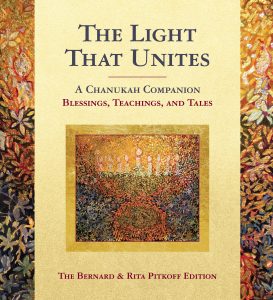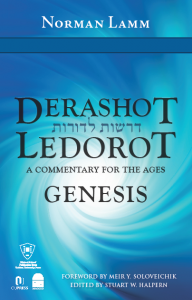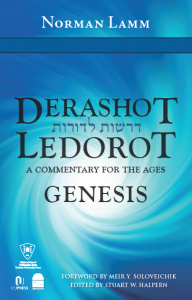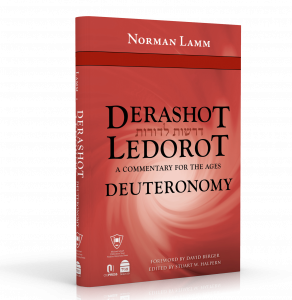Excerpted from Rabbi Shmuel Goldin’s Unlocking the Torah Text – Bereishit, co-published by OU Press and Gefen Publishing

Finding Yitzchak
Context
Yitzchak, the second of the three patriarchs, emerges as the most enigmatic. In stark contrast to the dramatic lives of both his father, Avraham, and his son, Yaakov, Yitzchak’s life (aside from the Akeida) seems unremarkable. He is characterized in the text as a passive man, buffeted by events, who rarely seems to take the initiative.
Questions
Who was Yitzchak? What were his challenges? Above all, what were his contributions to the patriarchal era and to Jewish history in general?
Approaches
A
The Torah is not a history book, and therefore does not provide us with full biographies of the personalities who populate its pages. We are given only the information that God deems necessary for the fulfillment of the Torah’s basic mission: the transmission of a Divine moral and ethical code to the Jewish people and the world.
Nonetheless, we can piece together pictures of our ancestors, based upon the information contained in the text. Incomplete as these pictures may be, they are nonetheless instructive. A better understanding of our ancestor’s lives, times and trials provides us with critical lessons concerning our own challenges today.
Careful study of the terse narrative of Parshat Toldot reveals patterns and themes within Yitzchak’s life. By analyzing these patterns we can catch a glimpse of the enigmatic second patriarch.
B
The first phrase of Parshat Toldot reads as follows: “These are the generations of Yitzchak, the son of Avraham; Avraham gave birth to Yitzchak…”
At first glance, the text seems not only redundant but unnecessary. We already know that Yitzchak is Avraham’s son. Why then, does the Torah find it necessary to repeat this fact not only once, but twice, in this introductory passage? Clearly the text is underscoring the fundamental relationship between the two patriarchs.
Who was Yitzchak? In many ways, the answer is that he was his father’s son. This relationship defined Yitzchak’s life and behavior.
Over and over again, we find Yitzchak experiencing the same circumstances as his father and repeating his father’s actions. Avraham and Sara were childless until God miraculously interceded; Yitzchak and Rivka are childless until God miraculously intercedes. Avraham had two sons, only one of whom would carry on his legacy; Yitzchak has two sons, only one of whom will carry on his legacy. Avraham confronted famine; Yitzchak confronts famine. Avraham dug wells; Yitzchak uncovers his father’s wells and then digs his own. Avraham asked Sara to pretend that she was his sister upon entering the territory of the Philistines; Yitzchak asks Rivka to pretend that she is his sister upon entering the territory of the Philistines. Avraham contracted a covenant with Avimelech; Yitzchak comes to an agreement with Avimelech.
The parallels are nothing short of astounding. Avraham clearly casts a powerful shadow over the life of his son.
C
So strong is the influence of Avraham that Yitzchak’s very relationship with God seems to be dependent upon his father. This fact is clearly mirrored in God’s conversations with the second patriarch: “And the Lord appeared to him [Yitzchak] and said: ‘Do not go down to Egypt…. Dwell in this land, and I will be with you and I will bless you…. and I will uphold the promise that I gave to your father, Avraham. And I will multiply your children as the stars of the heaven…. Because your father, Avraham, listened to my voice and observed my traditions, commandments, statutes and laws.’”
Later God reprises the refrain: “And the Lord appeared to him that night and said: ‘I am the God of your father, Avraham. Do not fear for I am with you and I will bless you, and multiply your children for the sake of my servant Avraham.’”
God bases his promises to Yitzchak on the merit of Avraham, rather than upon Yitzchak’s own merit. Is it possible that God understands that Yitzchak is unable to relate to his Creator, unless it is through the medium of his father’s memory?
The rabbis poignantly describe the overwhelming influence of Avraham on Yitzchak’s life in the following Midrashic passage quoted in the Talmud:
“And Avraham was old, well on in years”: Until Avraham’s day old age did not exist. Because of this fact, people who came to meet with Avraham would (in error) meet with Yitzchak, while those who came to meet with Yitzchak would (in error) meet with Avraham. Avraham, therefore, requested mercy from God, and old age was instituted.
In typical Midrashic fashion, the rabbis identify a fundamental problem facing Avraham. So identical are father and son that the patriarch is compelled to request from God the one gift essential for Yitzchak’s development: the personal space needed to allow Yitzchak to define his own identity.
D
As powerful as Avraham’s influence on his son may be, there are clear textual indications that Yitzchak successfully struggles to emerge from behind his father’s shadow.
The Torah discusses in detail the wells of water that Yitzchak digs. Some scholars accept this narrative on the level of pashut pshat. The text, they say, is describing the difficult effort of developing actual sources of water in Canaan, an effort that remains critical in the land of Israel to this very day. Others suggest that the wells be understood in Midrashic fashion. Water, they say, is often used as a symbol of Jewish tradition. The wells dug both by Avraham and Yitzchak refer to aspects of that tradition.
Whatever approach we choose, it is significant that Yitzchak not only uncovers the wells that his father dug and “calls them by the names that his father called them,” but also creates new sources of water and struggles with the Philistines concerning their ownership. Yitzchak certainly respects and reveres his father’s accomplishments. When the second patriarch digs his own wells, however, he moves beyond his father’s actions as he struggles to define his own personal historical role.
Similarly, Yitzchak’s agreement with the Philistine king, Avimelech, differs in significant ways from the flawed covenant that had been contracted in Avraham’s time. Yitzchak apparently learns from his father’s mistakes and is much more cautious in his dealings with the Philistines. (See Toldot 2 for a full discussion of the contrast between the two agreements.)
In these and other instances we catch a glimpse of the second patriarch’s efforts to move out from under the towering shadow of his powerful father and define his own unique identity.
E
Yitzchak’s personal struggles for self-definition become even more significant when seen against the backdrop of his unique place in Jewish history.
Yitzchak is the first Hebrew child. He is, therefore, the first individual within our history to face the challenge of preserving the Mesora (Jewish tradition). This challenge begins with the two steps of receiving and transmitting.
Yitzchak, unlike Avraham, receives his divine instruction not only from God, but from his parents. He must respect and absorb what his parents teach, often a considerable challenge.
God, for example, tells Avraham to climb Mount Moriah on the occasion of the Akeida. Yitzchak, on the other hand, receives no such commandment directly from God. His instructions are received from his father, Avraham. Nonetheless, Yitzchak faithfully follows his father’s instructions even to the point of potentially sacrificing his own life.
Upon receiving the tradition from his parents, the second patriarch must also successfully transmit that tradition to the next generation. Much of Yitzchak’s story centers on this particular task as he makes the difficult journey, with the help of his wife Rivka, towards understanding the true nature of his two children, Yaakov and Esav, and the legacy appropriate for each (see Toldot 3, Approaches c).
We often make the mistake, however, of defining Mesora simply in terms of the receipt and transmission of tradition. There is a pivotal additional step that must take place. To fully participate in the process of Mesora, an individual must receive tradition, make it his or her own, and then pass it down to the next generation.
Our ritual heritage is not simply the sum total of the hard-and-fast laws of the Torah, nor only the result of rabbinic interpretation and emendation. There is a personal component that involves us all. Jewish belief and practice change in subtle but significant ways as they course through the life of each Jew in every generation. We all contribute, consciously and unconsciously, to the complexion of our tradition. As a result, the Mesora that we pass down is different from the one we received. We each leave a personal mark upon our heritage.
On a national level, this phenomenon can be seen in the changing face of Jewish tradition throughout the journeys of our people. The communities of Spain, Poland, Lithuania, Morocco, Russia and countless others have each left an indelible and individual mark on the nature of our heritage. Judaism is richer and more beautiful for all of those communal contributions.
On a personal level, many of our own memories can prove the point. Judaism is not only the laws of kashrut and Shabbat, but the experience of a family Pesach Seder, the aroma of a grandmother’s gefilte fish, the kiss of a parent after the blessings on Shabbat Eve and so much more. Yitzchak’s efforts to define his own identity acquire greater urgency when seen in light of his unique place at the head of the chain of Jewish tradition. If the process of Mesora is to fully take root, the second patriarch cannot simply be a carbon copy of his father. He must actively determine and make his own contribution to the unfolding saga of his people. In this way he sets the stage for generations of Jews to follow, each of whom will be challenged to receive a tradition from their parents, make it their own, and hand it down to their children.
F
No discussion of Yitzchak’s life would be complete without mention of the Akeida as a formative experience. Yitzchak’s existence is undoubtedly shaped by the traumatic events that take place on the summit of Mount Moriah.
The rabbis point to two significant consequences of that overwhelming episode:
1. Yitzchak’s blindness was caused by the tears of the angels, which fell into his eyes as he lay bound on the altar.
2. Yitzchak is the only patriarch never to leave the land of Canaan. As he prepares to travel to Egypt in the face of famine, God appears and prohibits the journey. The rabbis explain that Yitzchak was considered a pure sacrifice. No other land was worthy of him.
Each of these rabbinic observations may well connect to one specific aspect of Yitzchak’s life that develops as a result of the Akeida. The dramatic events on the summit of Mount Moriah transform Yitzchak into the first “survivor” in Jewish history.
In this role the second patriarch becomes the paradigm of Jewish martyrdom across the ages. The rabbis in the Midrash refer to Yitzchak as “the first of the bound,” while the Talmud quotes Chana (who witnessed the brutal murder of her seven sons at the hands of the tyrant Antiochus) as saying, “My sons, go tell your father, Avraham: ‘You erected one altar; I erected seven.’”
It is only natural for someone who was a powerless victim of a deeply traumatic event to gravitate to strength and power in others. This phenomenon is evidenced today in the powerful bond between survivors of the Holocaust and the State of Israel. These individuals understand better than others the price to be paid when a people stand alone and stateless in the face of danger; and they appreciate beyond measure the way that the State of Israel has changed the nature of Jewish experience throughout the world.
Is it possible that Yitzchak’s “blindness” to the true nature of his sons, Esav and Yaakov, can be traced to the effect of the Akeida on the patriarch’s psyche? Perhaps, as a survivor, Yitzchak gravitates so powerfully to the physical strength of his older son, Esav, that he fails to see the faults that accompany that strength. Yitzchak, the passive patriarch, sees in Esav all that he, himself, is not; while Yaakov, the quiet son, is too similar to his father to be fully appreciated.
Yitzchak, as a survivor, can also not be allowed to leave the land of Canaan, even with a promise of return.
Survivors cannot live on dreams and promises. Only the concrete allows them to persevere. This fact is, once again, reflected today in the lives and accomplishments of Holocaust survivors throughout the world. Their drive to succeed – to build families and careers – and their invaluable contributions to their own communities and to the State of Israel reflect an overwhelming desire to create a new concrete reality. Only such a reality allows them to endure in spite of the horrific memories of past trauma.
Yitzchak, who would always live with the memory of his father raising the knife above him as he lay bound on the altar, could not be asked to leave the Land of Canaan. Only the concrete reality of living on his land would enable him to succeed.
 A Kabbalistic Perspective on the Thirty-Six Candles of Chanukah
A Kabbalistic Perspective on the Thirty-Six Candles of Chanukah










